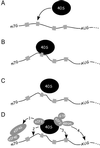The ribosome filter hypothesis
- PMID: 12221294
- PMCID: PMC129393
- DOI: 10.1073/pnas.192442499
The ribosome filter hypothesis
Abstract
A variety of posttranscriptional mechanisms affects the processing, subcellular localization, and translation of messenger RNAs (mRNAs). Translational control appears to occur primarily at the initiation rather than the elongation stage. It has been suggested that translation is mediated largely by means of a cap-binding/scanning mechanism. On the basis of recent findings, we propose here that differential binding of particular mRNAs to eukaryotic 40S ribosomal subunits before translation may also selectively affect rates of polypeptide chain production. In this view, ribosomal subunits themselves are considered to be regulatory elements or filters that mediate interactions between particular mRNAs and components of the translation machinery. Differences in these interactions affect how efficiently individual mRNAs compete for ribosomal subunits. These competitive interactions would depend in part on the complementarity between sequences in mRNA and rRNA, as well as on structural differences among ribosomes in different cell types. By these means, translation may either be enhanced through increased recruitment of ribosomes or inhibited through strong interactions that sequester mRNAs. We propose that ribosomal filters may be important in cell differentiation and describe experimental tests for the filter hypothesis.
Figures

Comment in
-
The ribosome prophecy.Nat Rev Mol Cell Biol. 2015 May;16(5):268. doi: 10.1038/nrm3993. Nat Rev Mol Cell Biol. 2015. PMID: 25907611 No abstract available.
References
-
- Guhaniyogi J. & Brewer, G. (2001) Gene 265, 11-23. - PubMed
-
- Modrek B. & Lee, C. (2002) Nat. Genet. 30, 13-19. - PubMed
-
- Brett D., Pospisil, H., Valcarcel, J., Reich, J. & Bork, P. (2002) Nat. Genet. 30, 29-30. - PubMed
-
- Mohr E. & Richter, D. (2001) Int. J. Biochem. Cell Biol. 33, 669-679. - PubMed
-
- Gao F. B. (1998) BioEssays 20, 70-78. - PubMed
Publication types
MeSH terms
Substances
Grants and funding
LinkOut - more resources
Full Text Sources
Miscellaneous

